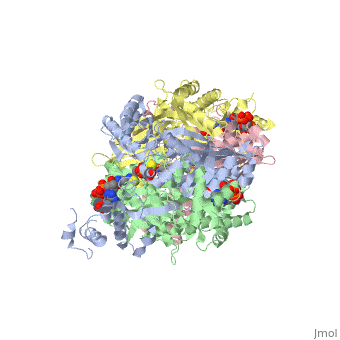G13SecL03Tpc3
From Proteopedia
| Line 1: | Line 1: | ||
| - | == | + | == Osp B of Borrelia burgdorferi == |
<StructureSection load='1dq8' size='350' side='right' caption='Structure of HMG-CoA reductase (PDB entry [[1dq8]])' scene=''> | <StructureSection load='1dq8' size='350' side='right' caption='Structure of HMG-CoA reductase (PDB entry [[1dq8]])' scene=''> | ||
Anything in this section will appear adjacent to the 3D structure and will be scrollable. | Anything in this section will appear adjacent to the 3D structure and will be scrollable. | ||
Revision as of 13:32, 14 August 2012
Contents |
Osp B of Borrelia burgdorferi
| |||||||||||
Introduction
Borrelia burgdorferi are motile spirochetes that are carried by a hard- bodied deer tick of the family Ixodidae. Lyme disease, caused by Borrelia burgdorferi, is involved in many serious disorders of the skin, nervous and cardiac system. The bacterium consists of outer surface proteins that play an important role in helping the bacteria colonize and survive in the tick. Of these, a major lipoprotein is Osp B. This outer surface protein has a property of becoming lysed without a direct complement with the antibody. Specifically, the C terminus on the Osp B contains a Lysine residue that recognizes the destructive IgG antibody, H6831.
Structure
Osp B extends from Serine- 157 to Lysine- 296. It consists of twelve anti parallel beta sheets and one alpha helix. Sheets 1- 4 form a freestanding sheet, where sheets 5-12 form a barrel like domain. The Fab binding domain is in the center of the central beta sheet, residues 152-296.
Interactions
The structure of Osp B shows that there are three exposed loops in which are affected by the antibody, H6831. The majority of interaction comes between the antibody’s heavy chain and loop 2 on the lipoprotein, residues 250-254. Lysine 253, which resides on loop 2 play an important role in the recognition of the antibody, thus the antibody having the most interaction with loop 2. Loop 1, residues 231-233, also interacts with the Fab heavy chain as well as loop 3, residues 272-276, interacting with the light chain.
Structural changes
The more significant change that occurs from the bactericidal antibody is in the first four beta sheets. The surrounding sheets shift and overlap to replace the missing sheets. The removal of these sheets can affect the structure and stability of the outer surface protein making it more susceptible to lysis.
Destruction
The bacteria lyses indirectly, by a membrane attack complex (MAC). The complement system activates the classical pathway, activating effector proteins which insert themselves in the outer membrane of the bacteria and disrupting it and causing death to the cell.

